Spring semester 2021: Pandemic-era Berkeley in 40 photos
Wonder what's happening on campus? Come, take a look.

March 1, 2021
Next week will mark the year anniversary of COVID-19 being declared a pandemic and UC Berkeley switching to online instruction. Whether you’re in on-campus housing this semester, living elsewhere in the Bay Area, still in your hometown or on distant shores, the Bear Territory we used to know still feels like a much-used adjective these days — remote. So, with second semester well underway, here’s a peek at your campus, where we hope you’ll be glad to see that signs of perseverance, resilience and newness are as prevalent at the coming of spring.
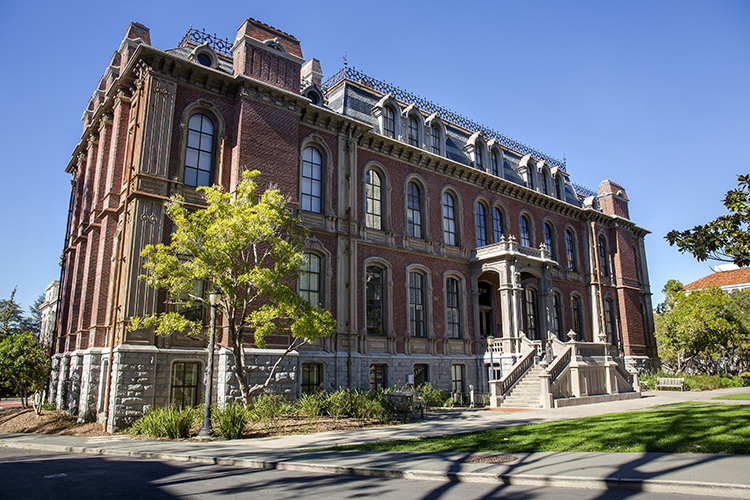
Historic and charming South Hall, built in 1873 and UC Berkeley's oldest building — it's the sole survivor of the campus's original nucleus — has had its exterior restored. On a recent sunny day, it sported new roof shingles and flashing, restored wood cornices, resealed and cleaned masonry and granite, and resealed third-floor dormers and windows. Repairs also have been made to the exterior's east portico and stairs. (Photo by Brittany Hosea-Small)

South Hall was wrapped up for repairs in July 2020, as seen in this photo. The building is a rare example, particularly on the West Coast, of the Second Empire Style, a European design that swept the country in the last half of the 1800s. (Photo by UC Berkeley Capital Strategies)
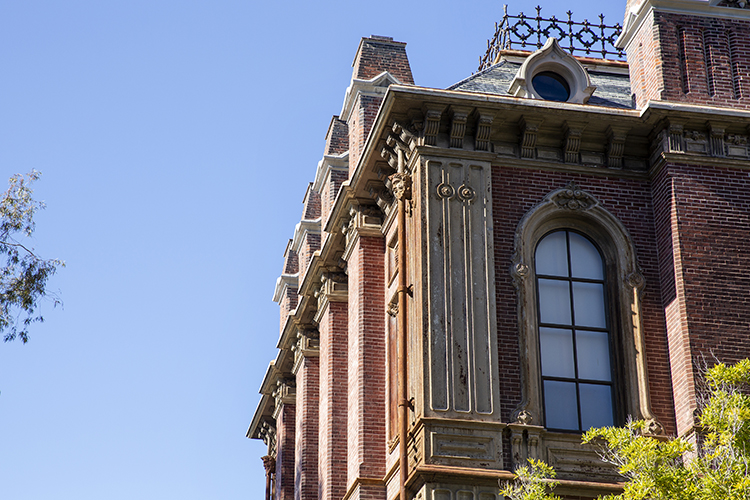
The repair of South Hall's exterior was an urgent priority for the campus, in order to preserve the hall's architectural heritage — South Hall was added to the National Register of Historic Places in 1982 — and to avoid future costly repairs due to avoidable weather damage. This is a close-up view of the ornamental wooden cornices, with glimpses of one of the building's round oeil-de-bouef windows and the rooftop's decorative iron cresting. (Photo by Brittany Hosea-Small)
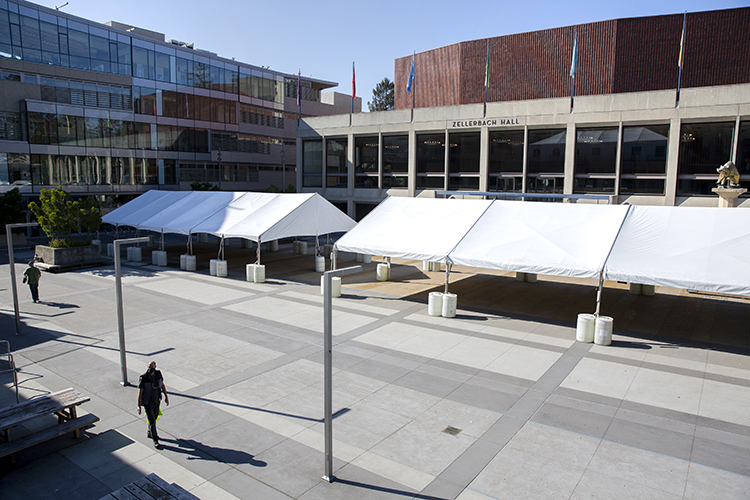
The campus has set up tents this semester in spots such as Lower Sproul Plaza for occasional outdoor instructional activites. Occupancy is limited to 12 students and one instructor. All participants must be tested weekly for COVID-19 and show proof to student health ambassadors before attending these sessions. The outdoor offerings — also in the Greek Theater, the Berkeley Haas courtyard and elsewhere — are augmenting regular remote delivery of instruction. A pilot program last fall resulted in zero positive cases of COVID-19. (Photo by Brittany Hosea-Small)
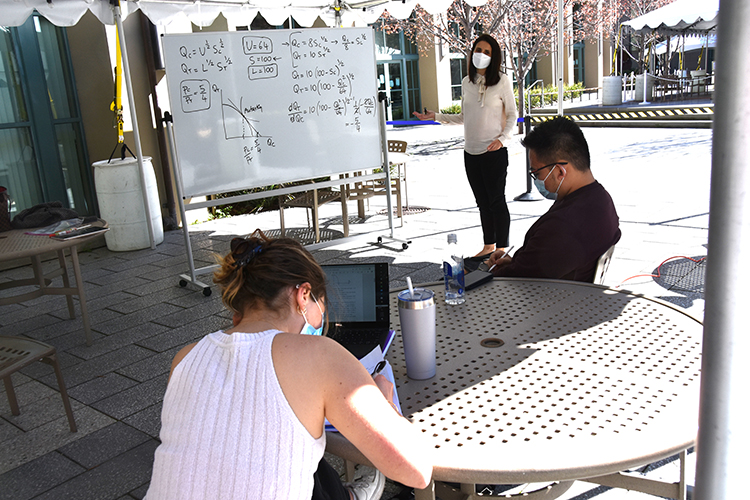
Matilde Bombardini, associate professor of business and public policy at Berkeley Haas, holds an outdoor session in late Februrary in the business school's courtyard with undergraduates in her international trade course. At the table are students Kelly Morali (left) and Dafi Siregar.
(UC Berkeley photo by Hulda Nelson)

Instructor Leighton Fong (center) leads a small group rehearsal in the breezeway between Morrison and Hertz halls with (clockwise from left) violinists Oliver Marcus, Margaret Cheung, Isaac Harris and Andrew Ramirez. They are students in Music 141, the UC Berkeley Symphony Orchestra, which is a required course for music majors in the orchestra. While the main class meets virtually this academic year, the campus's outdoor pilot program allows orchestra students to rehearse in smaller groups in person. (UC Berkeley photo by Gretchen Kell)
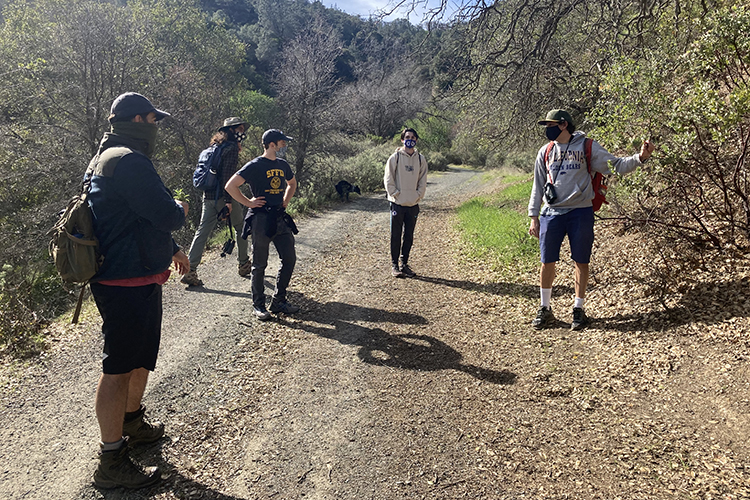
Professor Paul Fine leads students on a hike in the East Bay hills as part of Integrative Biology 198, an undergraduate in-person field seminar called California Woody Plants. Most of the students took his fall semester 2020 Ecosystems of California course that also had an in-person component. Here, Fine (right) teaches students how to identify Arctostaphylos auriculata, a species of manzanita endemic to the area. (Photo by Isaac Lichter Marck)
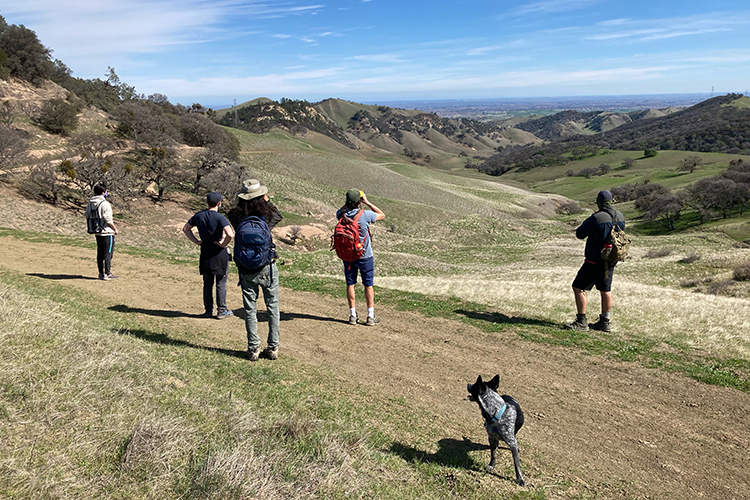
Students on the
Feb. 25 East Bay hills hike, and a dog named Rio, pause to take in the views. Fine offered this class because of the pandemic "to give students something fun and rewarding to do outside," he said. "It's a chance for us to get to know each other more and to see more Bay Area plants." (Photo by Isaac Lichter Marck)

Davis, a Green Valley resident, has had a live-work space on the Campanile's sixth floor. He stayed there for two straight days after the 1989 Loma Prieta quake, unable to get back to San Francisco, where he lived at the time.
Brittany Hosea-Small for UC Berkeley
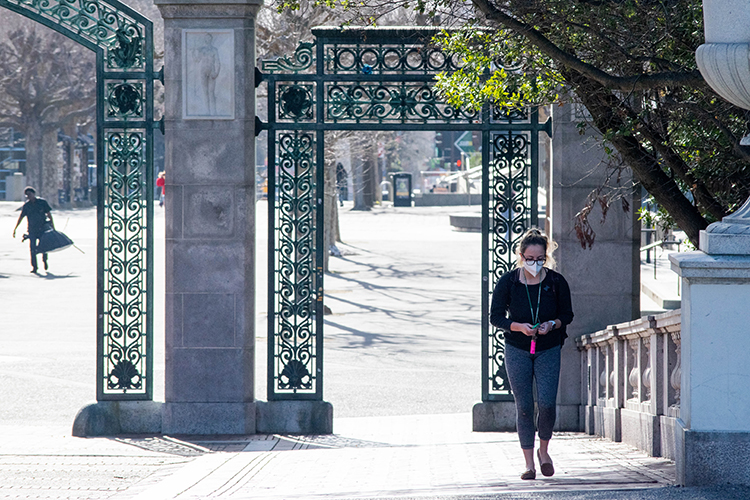
This semester, students living in Berkeley's on-campus residential halls, apartments and suites must be tested for COVID-19 twice a week by University Health Services. Faculty, staff, students and postdocs with permission to work in person on the central campus or in buildings adjacent to it are required to be tested once a week. (UC Berkeley photo by Irene Yi)
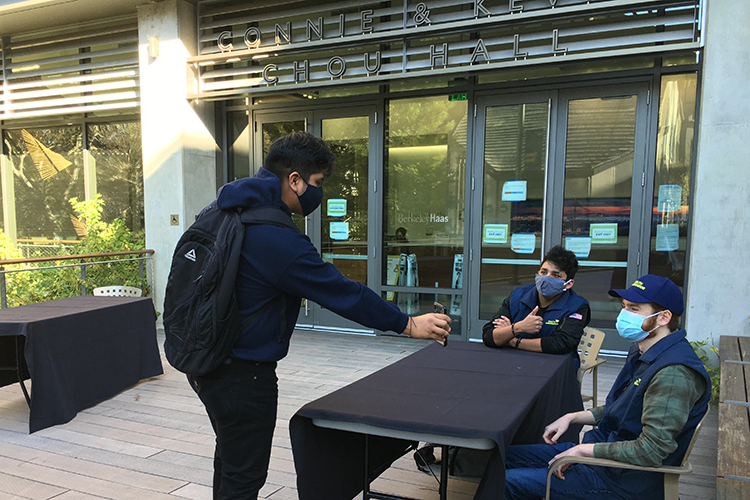
Approximately 75 students, including Daniel Acevedo Garcia (middle) and Bo Romans (right), have been hired this semester by the new University Health Ambassador Program to check student, staff and faculty compliance with required campus COVID-19 surveillance testing at the entrance to key buildings, like Connie and Kevin Chou Hall. These student health ambassadors also promote compliance with masking, distancing and building capacity. (Phoo courtesy of Cal Performances)

Student Jonas Willett shows his e-badge, which is green with the word "Cleared" in bold black type on his cell phone screen, to a student health ambassador at a table outside Crossroads dining commons. The green color indicates that a student, staff or faculty member is current with campus COVID-19 surveillance testing. (UC Berkeley photo by Hulda Nelson)
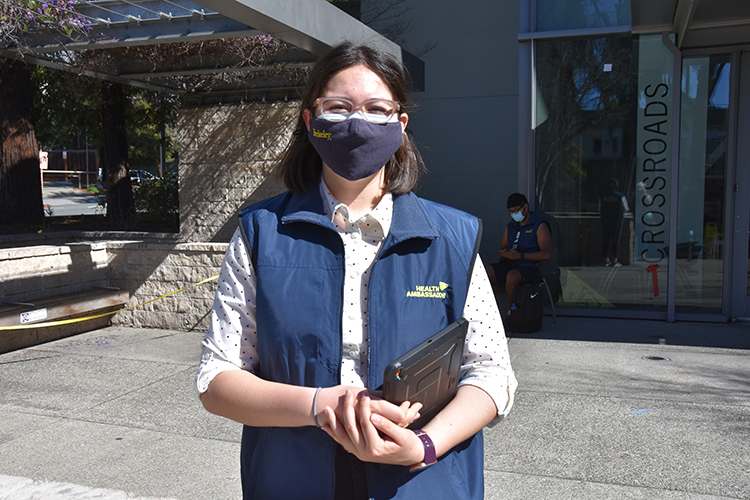
Gabriela Mackie is one of the campus's 15 student area managers who oversee small groups of student health ambassadors. Each manager supervises ambassadors at several sites where people need to show proof of regular COVID-19 surveillance testing. (UC Berkeley photo by Hulda Nelson)
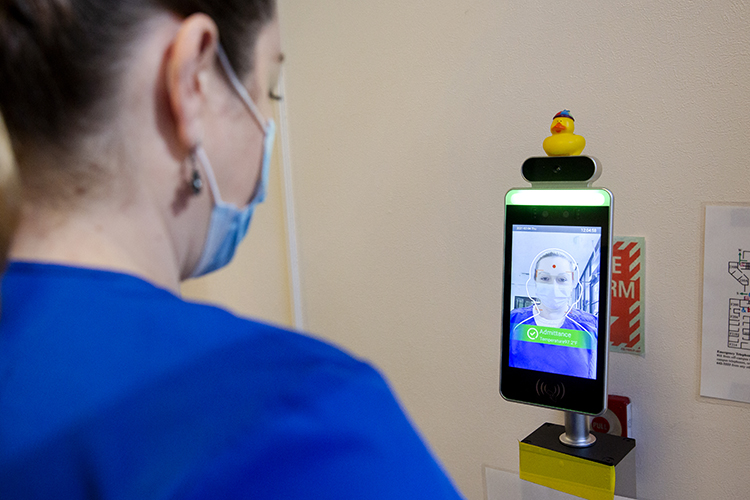
Many buildings, like Minor Hall, pictured here, could only be accessed after a temperature screening. (Photo by Brittany Hosea-Small)
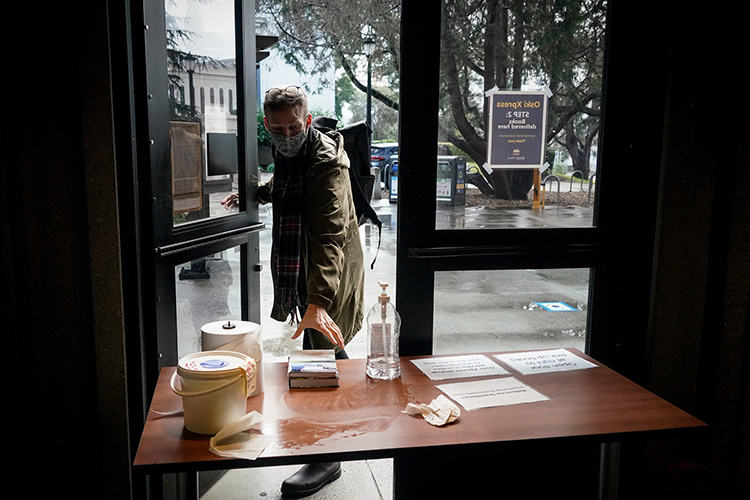
At Moffitt Library, a borrower picks up a book as part of Oski Xpress, a contactless book pick-up service available to those with a current Cal 1 card or UC Berkeley library card. Fourteen campus libraries are participating in the service. (Photo by Jami Smith for the UC Berkeley Library)
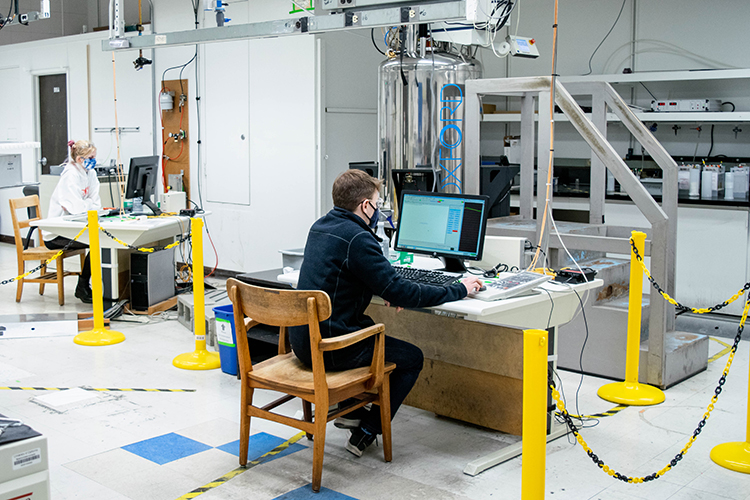
In the College of Chemistry Nuclear Magnetic Resonance Facility in Latimer Hall, graduate students in chemistry Abby Medlin (left) and T. Alex Wheeler are separated by blue and gold stanchions and plastic chains as they work acquiring nuclear magnetic resonance spectra. Since the pandemic began, students have been required to book time at the lab so that only one person is at a computer station at a time. (UC Berkeley photo by Irene Yi)

After a brief hiatus, all of Cal’s 30 intercollegiate athletic programs competed under COVID-19 protocols. (Photo by Brittany Hosea-Small)
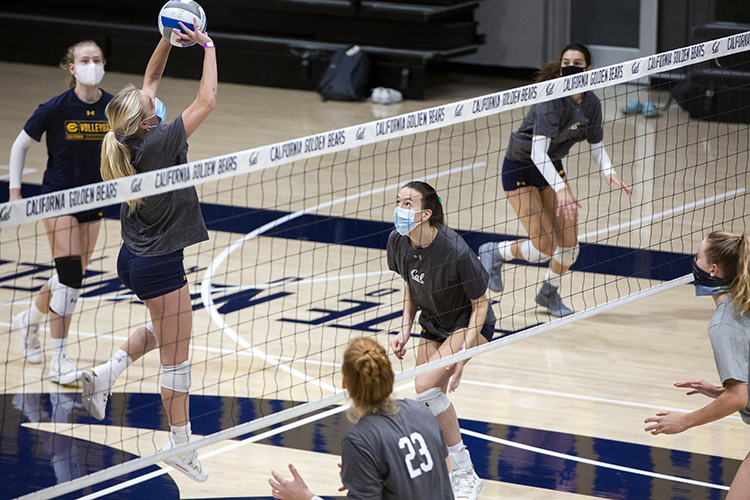
Cal's athletic teams are taking special steps to mitigate the risk of spreading the coronavirus. The women's volleyball team wears masks during both practices and games this season. (Photo by Brittany Hosea Small)

Pink flowering trees outside the Valley Life Sciences Building were shedding petals in the final days of February as students studied in the spring green grass. (UC Berkeley photo by Gretchen Kell)
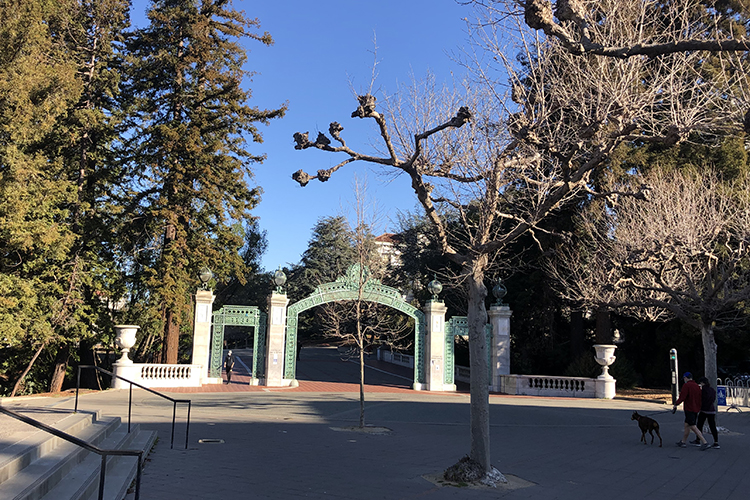
At 8:30 a.m. on Monday, March 1, Sather Gate was far from the lively thoroughfare it was just a year ago. (UC Berkeley photo by Gretchen Kell)
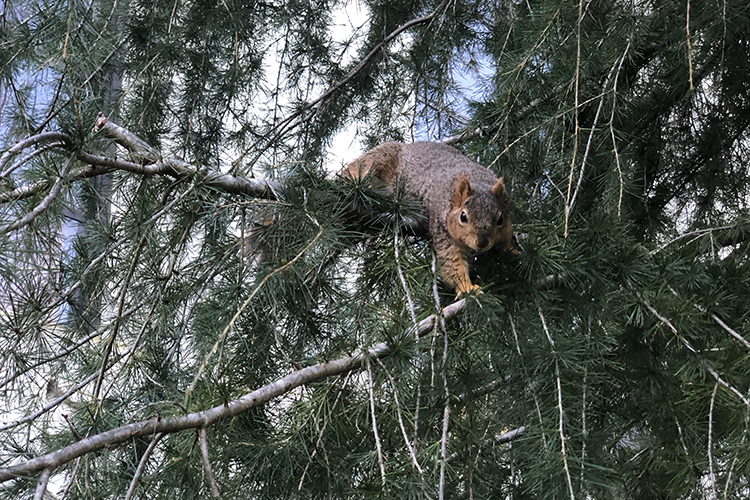
Squirrels on campus seemed more plentiful than people as they foraged for food in and under trees near the Valley Life Sciences Building. (UC Berkeley photo by Gretchen Kell)

Since the Oct. 29 attack, Annie has been observed chasing the peregrine falcon pair that attacked Grinnell. (Cal Falcons image)

On the Campanile, where longtime peregrine falcon residents Annie and Grinnell were first seen setting up territory in December 2016, Bernie Sanders recently braved the rain to get a front row seat for Annie and Grinnell's fifth year of parenting. Any thoughts on names for this year's chicks? (Cal Falcons image)

A long line of students, staff and faculty with appointments for COVID-19 vaccines is a regular sight outside of the Martin Luther King Jr. Student Union. The vaccines are given in Pauley Ballroom. (Photo by Brittany Hosea-Small)
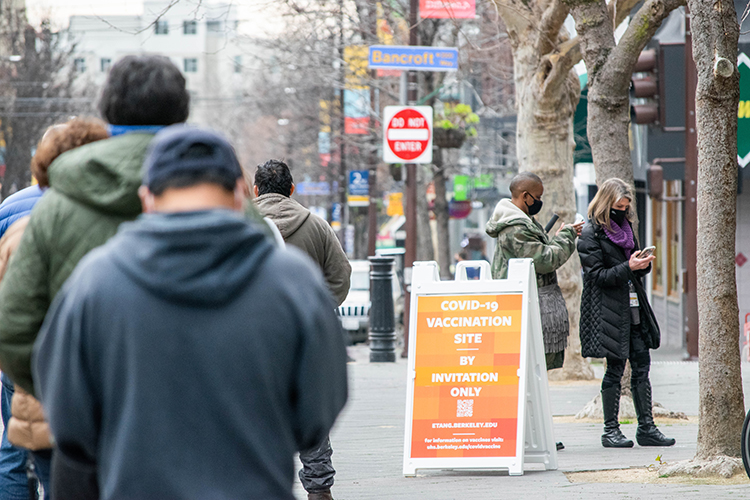
Campus health care workers were the first to receive emailed invitations for a vaccine, then employees at highest risk of severe disease: those 65 and older currently working on campus and all employees 75 and over. Individuals are advised to bring a pay stub and their Cal ID to their appointments. (UC Berkeley photo by Irene Yi)

Lisa Polley, infection control manager for University Health Services, readies yet another syringe for the COVID-19 vaccine clinic in the MLK Jr. Student Union's Pauley Ballroom. Vaccinations began in mid-January; so far, close to 3,500 doses have been administered to members of the campus community and Lawrence Berkeley National Laboratory. (Photo by Brittany Hosea-Small)
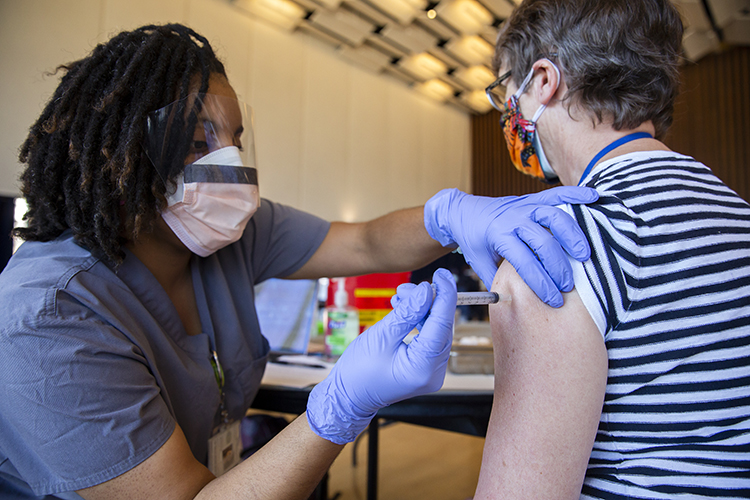
Frances Houle, a senior scientist at Berkeley Lab, gets a vaccine at Pauley Ballroom from Jamaica Howell, a Berkeley Lab medical assistant. "I think it's a miracle," said Houle, after receiving the injection. "Our family is so excited." (Photo by Brittany Hosea-Small)
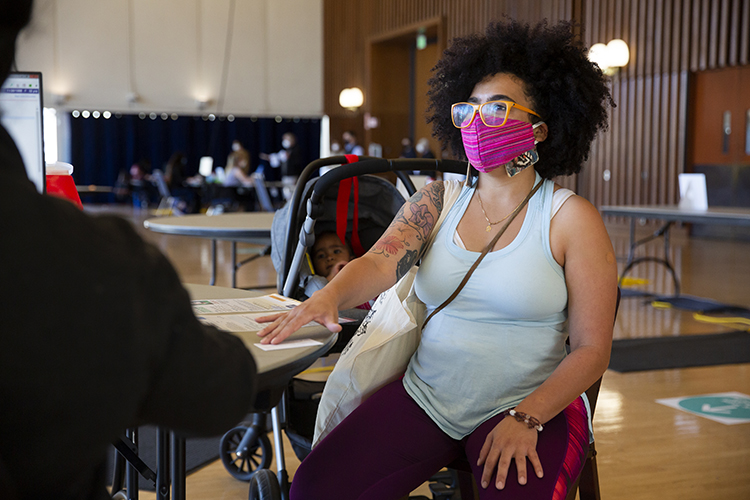
Despite having what she called a "healthy skepticism" about vaccines, because of the history of medical racism in the U.S., Graduate School of Education student Krista Cortes signed up for the COVID-19 vaccine, explaining that she wanted to "do my part" to help end the pandemic. "It was very scary, the whole year," she said of 2020. Cortes also is a community adviser at University Village. (Photo by Brittany Hosea-Small)
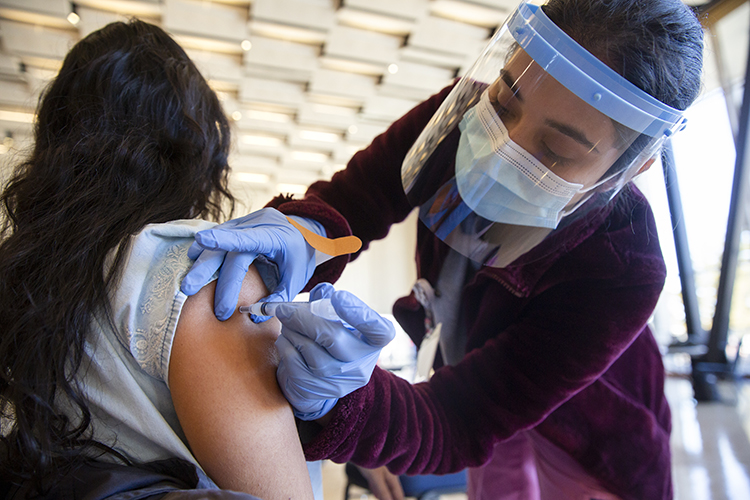
Cecilia Mejia receives a COVID-19 vaccine in Pauley Ballroom from Andrea Gomez, a University Health Services nurse. Mejia, a fourth-year conservation and resource studies student, is a senior resident assistant in Blackwell Hall. (Photo by Brittany Hosea-Small)
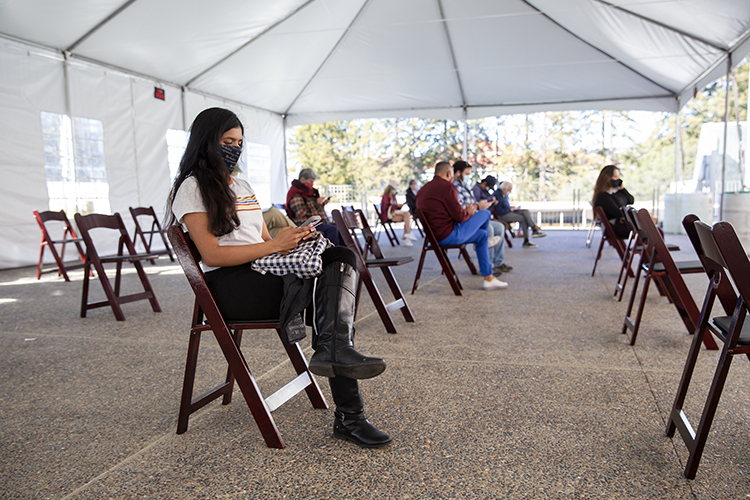
Those who receive vaccines in Pauley Ballroom are then monitored for vaccine reactions by health care volunteers in the Berkeley Medical Reserve Corps. The monitoring area is under a large tent on the balcony outside of the ballroom. (Photo by Brittany Hosea-Small)

Hanna Kim, a third-year student majoring in molecular and cell biology, is a member of the Berkeley Medical Reserve Corps. She and other Berkeley students in the corps staff the tent on the deck off Pauley Ballroom, monitoring people who have just received vaccines and keeping folding chairs and other surfaces clean. (Photo by Brittany Hosea-Small)
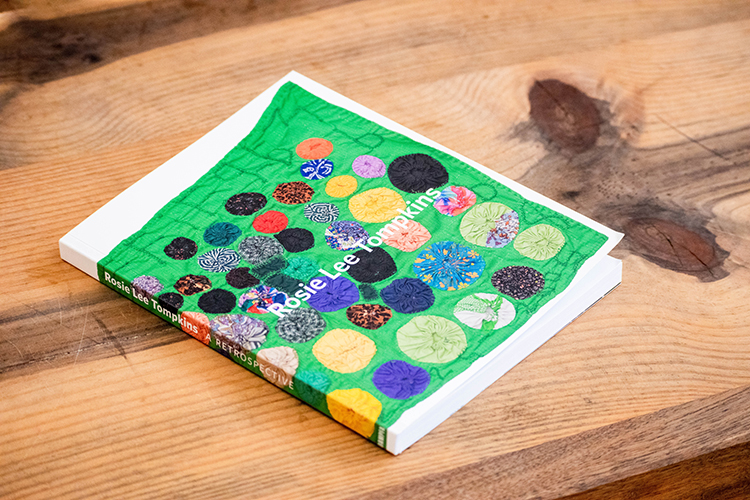
After the New York Times placed the Berkeley Art Museum and Pacific Film Archives's catalog for the "Rosie Lee Tompkins: A Retrospective" exhibit on its list last November of the top 10 art books of 2020, 1,000 copies have been sold by the museum. Staff members at the BAMPFA, which closed last March because of the pandemic, are buoyed to see such interest in the exhibit, which showcased African American improvisational quilt-making, especially "during this period of multiple challenges" in the U.S., said A.J. Fox, media relations manager at the museum. (UC Berkeley photo by Irene Yi)
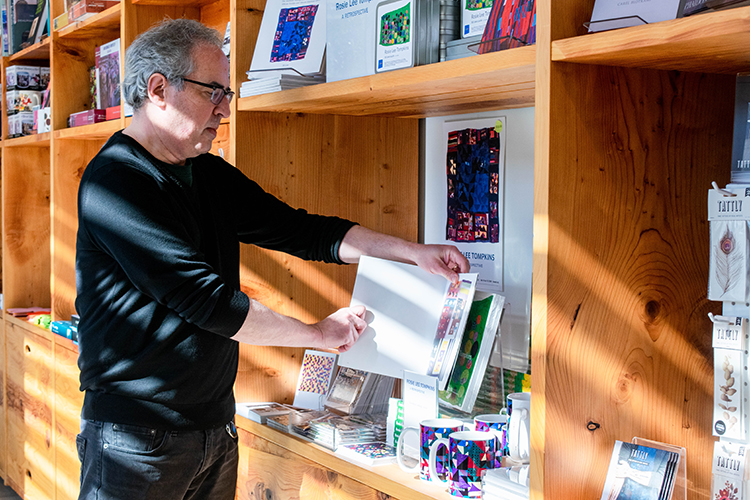
The BAMPFA is closed, but fans of the highly acclaimed exhibit "Rosie Lee Tompkins: A Retrospective" have clamored to order copies of the exhibition catalog and other items that celebrate the artistry of Tompkins, a brilliant, inventive quiltmaker. New York Times articles about the exhibit and Tompkins helped. At a tough time for museums, "this is the perfect example of resilience," said Jim Sugarman, BAMPFA's sales and admissions manager, photographed here in the museum store. (UC Berkeley photo by Irene Yi)
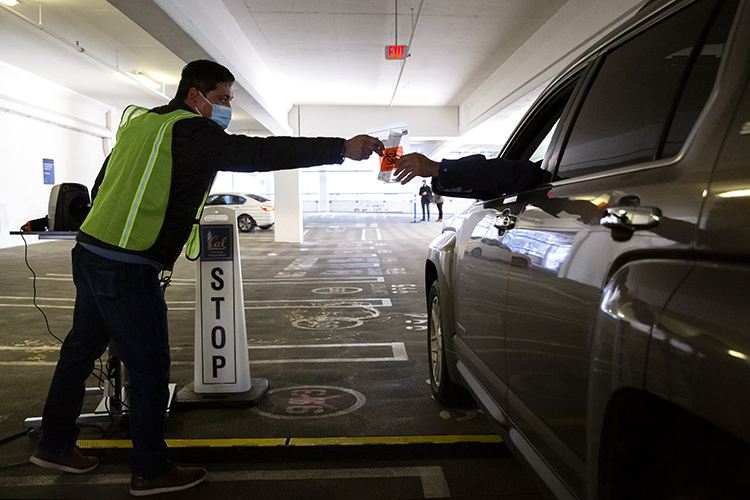
Early in 2021, students, staff and faculty could get a drive-through COVID-19 test at Underhill Parking Gararage. (Photo by Brittany Hosea-Small)
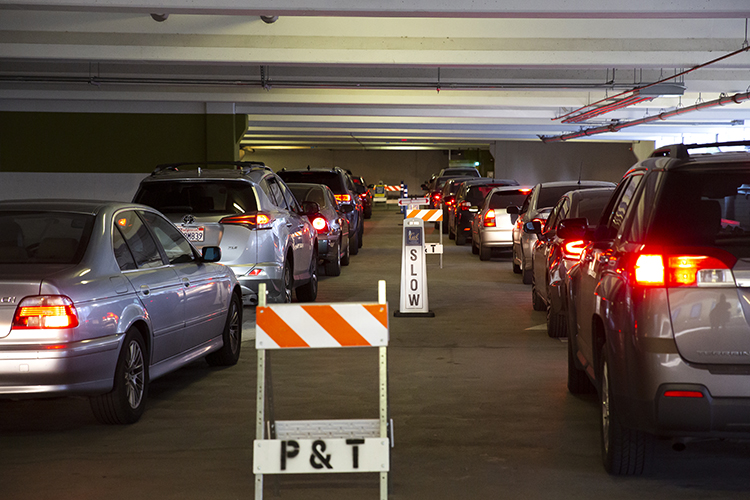
In the Underhill Parking Garage, drive-through testing for COVID-19 began in January. It features later hours — until 6 p.m. — to accommodate swing shift employees. (Photo by Brittany Hosea-Small)

Undergraduate Abena BakenRa distributes two free Cal masks to all students with a campus I.D. at the Martin Luther King Jr. Student Union. The ASUC effort has given out nearly 8,000 masks since late August. Student government also allows students to book study rooms in the building if they need a quiet study space — one student per room — with free Wi-Fi. (Photo by Brittany Hosea-Small)
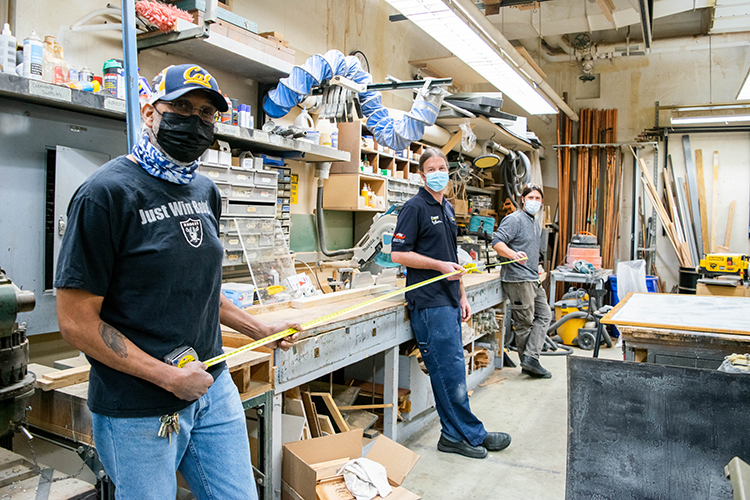
Many essential workers continued to work on campus, being sure to stay socially distant. (UC Berkeley photo by Irene Yi)
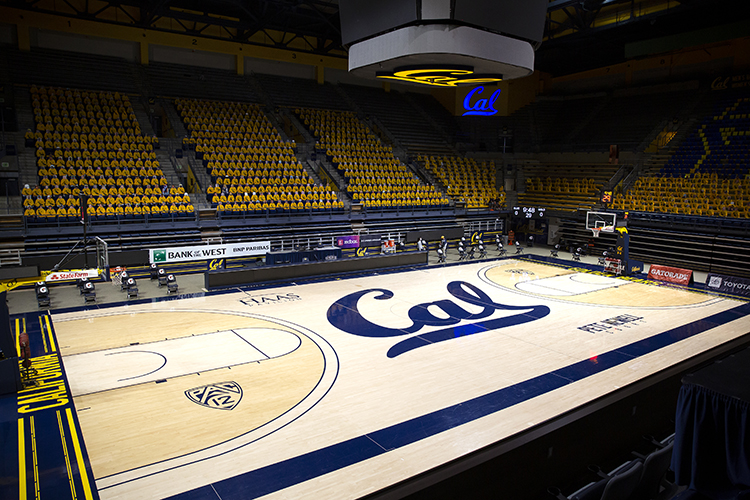
Berkeley's athletic venues were empty most of the year. (Photo by Brittany Hosea-Small)
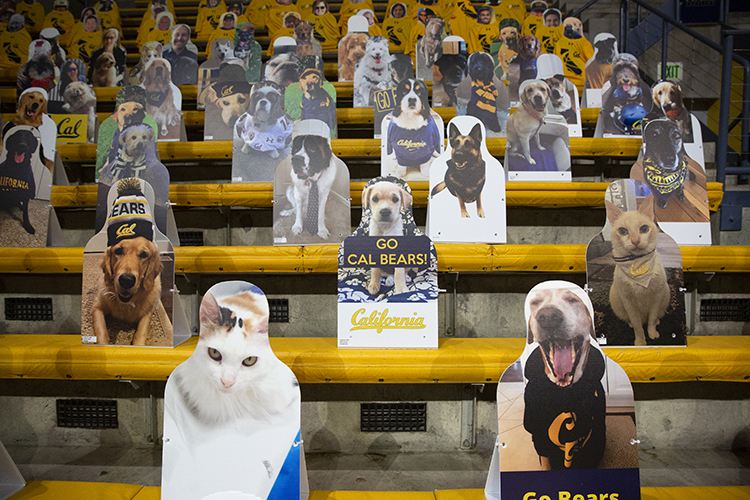
Photos of fans' pets and babies "have been a go-to" when Cal Athletics supporters choose who or what to depict on their cutouts, said Corwin. All proceeds go to the Cal Athletics Fund for student-athletes. (Photo by Brittany Hosea-Small)
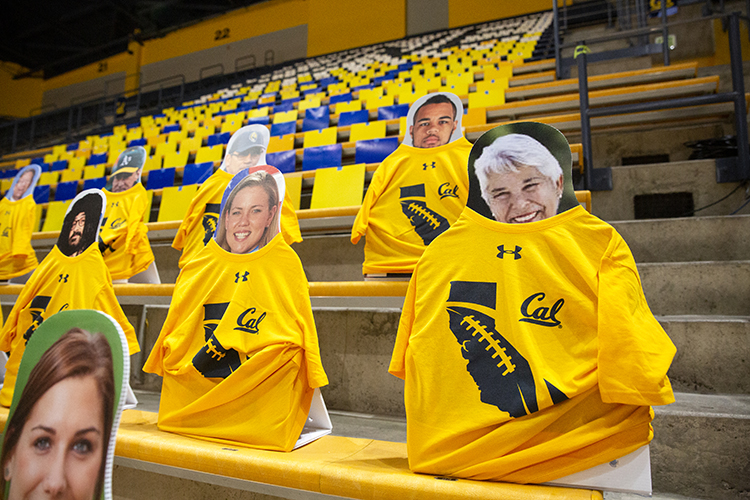
Each weather-resistant cutout is installed at the donor's choice of Cal Athletics sports venues, such as Haas Pavilion or California Memorial Stadium. Cardboard faces in the mix include recent Berkeley Nobel laureates, famous alumni and Chancellor Carol Christ. (Photo by Brittany Hosea-Small)